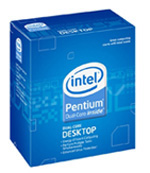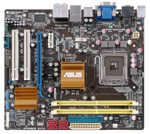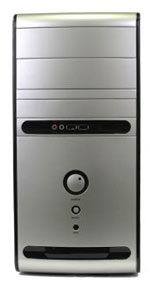Intel Entry-level PC
Intel still owns the pole position in CPU performance, but the area from entry to upper midrange is very competitive between Intel and AMD. In fact, as pointed out in the recent Phenom II Buyers' Guide, AMD is often the better value in the broad midrange category. The only area still dominated by Intel is the very top, where CPUs cost $280 and more.
The one advantage that remains for Intel is that their processors generally overclock better than current AMD CPUs. That has changed with Phenom II in the midrange, but most of today's entry AMD processors still use older designs that do not overclock as well as Intel choices. Overclocking is not normally a consideration in entry computers, but it could be for some buyers, and at the lowest rungs of the CPU ladder Intel processors remain the best overclockers for now.
| Intel Entry-level PC | ||
| Hardware | Component | Price |
| Processor | Intel Pentium Dual-Core E5200 Wolfdale (Dual-core 2.5GHz, 45nm, 65W, 2MB shared L2, 800FSB) | $70 |
| Cooling | CPU Retail HSF | - |
| Video | On-Board | - |
| Motherboard | ASUS P5QL-CM G43 HMDI uATX | $80 |
| Memory | Patriot Viper Model PVS24G6400LLK 4GB DDR2-800 4-4-4 ($52 less $25 Rebate) | $27 |
| Hard Drive | WD Caviar GP WD5000AACS 500GB | $55 |
| Optical Drive | Sony Optiarc Model AD-7240S-OB 24X DVDRW SATA | $24 |
| Audio | On-Board | - |
| Case | SIGMA La Vie LBYWBP Leather Mid-Tower w/ 500W PSU ($65 less $20 Rebate) | $45 |
| Power Supply | 500W Included with Case | - |
| Base System Total | $301 | |
| Display | Acer X193W+BD 19" 5ms Widescreen LCD (1680x1050) | $110 |
| Speakers | Cyber Acoustics CA3090WB 2.1 Gaming Speakers | $16 |
| Input | Microsoft CA9-00001 PS/2 Keyboard and Optical Mouse | $17 |
| Operating System | Microsoft Vista Home Premium SP1 (for System Builders) | $99 |
| Complete System Bottom Line | $543 | |
 |
Our choice for the Intel entry CPU remains the excellent 2.5GHz dual-core E5200 Wolfdale. This 65W rated CPU is built on Intel's 45nm manufacturing that begs you to overclock. The E5200 uses a default 800FSB, so right out of the box the first option for overclocking, if you are so inclined, is to bump it up to 1066 bus. That will give you a 33% overclock and a final speed of 3.33GHz, and it is readily attainable with proper cooling. Even if you never overclock you will be very pleased with the performance of the E5200.
The E5200 is an easier choice now that the price has dropped from $83 a few months ago to $70 today. We do not recommend going lower than an E5200 in an Intel system because the trade-offs in performance for the few dollars saved are too great. The performance of the E1200 at $50, for example, is dismal compared to the E5200, and certainly not a good choice in performance for the $20 saved. The only drawback to this processor choice is the lack of Intel's Virtualization Technology (Intel VT). If running the Windows Virtual PC under Windows 7 for XP Mode (as one example) is important to you, then moving up to the E8x00 range or down to the E6x00 allow the best VT options in this range, although this budget point is no longer valid.
Unlike the numerous AMD product choices in the $60~$80 price range that feature current chipsets and loads of features, the Intel selections are mostly limited to older chipsets like the G31 or NVIDIA GeForce 7100 series. These chipsets are stable, well supported, and are valid options for basic entry-level systems. Intel is promoting the G41 chipset into this price range now and we seriously considered a couple of very good G41 boards, but they featured VGA output or the storage options were limited due to the ICH7 for the type of system we had in mind. Fortunately, ASUS came through with some timely price reductions on their G43 based ASUS P5QPL-CM motherboard and it was an easy decision to choose this particular board for our budget based system.
 |
The P5QL-CM features the latest G43 GMCH along with the ICH10 Southbridge. The GMA X4500 graphics engine does not feature the hardware accelerated H.264/VC-1/MPEG2 decoding capability of the G45 or NVIDIA GeForce 9300 chipsets, but HD video playback is acceptable with a decent processor like the E5200. Otherwise, the performance of the G43 is fine for SOHO applications, flash-based games, and general video duties. However, insert a discrete video card like the HD 4770 and any weaknesses of the G43 chipset go away in an instant.
The P5QL-CM features support for the latest Core 2 Duo, Core 2 Quad, and Pentium/Celeron dual-core processors along with 8GB memory support. The board has a very good layout with one PCIe x16 slot, one PCIe x1 slot, and two PCI slots. The ICH10 does not support RAID but does provide six SATA 3Gb/s ports, one IDE port, and twelve USB 2.0 ports. ASUS includes the 8-channel VT1708B HD audio codec, Realtek RTL8111B Gigabit LAN, and DisplayPort, DVI-D, and VGA video out ports. ASUS based this motherboard on the uATX form factor and it includes a basic accessory kit along with several ASUS specific software applications. The board has proven to be very stable and problem free over the last 30 days. It is not an overclocking demon with our E5200/E7200 being limited to the 345FSB range due to the chipset, but that is more than enough headroom (4.16GHz with the E5200) for most users.
 |
The case and power supply choice are the same Sigma La Vie 500W Mid Tower chosen for the AMD entry system. At a final price of $45 for this good-looking, side-window case and Sigma 500W power supply it is a value that is hard to pass up. If you prefer a smaller Micro ATX case, the HEC 6K28BSOH48D mini tower is a good alternative. HEC is best known as a manufacturer of power supplies. Some are sold under their own name, but most are manufactured for other well known power supply brands. HEC includes a 485W PSU with this attractive mini tower, which should provide plenty of power for your entry build.
Other components are the same ones chosen for the AMD Entry system. Some readers will also notice that our link for the Windows Vista Home Premium System Builders OS is for the 64-bit version. Whether you choose 64-bit or 32-bit, the price of Vista is the same. The choice is yours, but you will need the 64-bit version to fully use the 4GB or more system memory. While 64-bit has made giant strides in drive and component compatibility, if you have an old printer or other peripherals you want to bring from Windows XP to Vista you need to check compatibility very carefully. 32-bit Vista generally works with almost anything that worked with Windows XP, but that is not always true of 64-bit. If you are starting fresh, we recommend choosing 64-bit Vista.
If we compare the two entry-level systems, the winner depends on what is of more value to you. The Intel system is a bit more powerful, but you can move up to a high-end Athlon X2 or a low-end AMD Phenom II X3 for comparable performance at less than $85. If you are an overclocker, the Intel entry may be your best choice. For a gamer, the AMD offers more flexibility for future expansion. For the typical entry-level PC right now and for what the system typically is used for - internet, office, low-end gaming, and low to mid graphics - you can go either route and be very happy.










65 Comments
View All Comments
strikeback03 - Thursday, May 14, 2009 - link
So it's pretty much a different keyboard with a touchpad for more money? I suppose they could have recommended a DiNovo mini as well, I'd imagine the input devices used are definitely part of the "personal touch" mentioned for the HTPCs.aftlizard - Thursday, May 14, 2009 - link
59.99 would still keep them under there stated budget and 90 dollars less than the Dinovo keyboard while taking up less space, using less batteries and providing better range than RF.GeorgeH - Thursday, May 14, 2009 - link
"The WD Green is a variable speed energy saving design"Unless I'm very much mistaken, that WD drive does not vary its rotation speed. Their original "5400-7200" RPM claims were purely a marketing thing, a shorthand way of saying "5400RPM power consumption with 7200RPM performance". WD no longer bothers to claim their drives vary in speed, instead merely listing it as "IntelliPower" and nothing more.
Saying it's variable speed is good marketing for people who don't see anything beyond RPM, but as AnandTech isn't on WD's payroll it seems a little out of place here. ;)
Spoelie - Friday, May 15, 2009 - link
What intellipower means is that the caviar green line is engineered to meet a power target, not a (rotational) speed target. They guarantee that the speed is at least 5400rpm tho.If the power budget is 7w, and the current design allows this by spinning the disks at 5800rpm, then that is what you get. The next design revision could bump up the speed to 6100rpm while keeping the same power budget (for example, optically shrunk controller chips, or increased density platters -> less platters needed for the same capacity -- both save power which can be spent increasing rotational speed). That's why you have the caviar green EACS, EADS, ...
coda6 - Thursday, May 14, 2009 - link
I agree, I would love to see an article on Anands HTPC set up, or at least a discussion on the possibilities of the current HTPC tech.goinginstyle - Thursday, May 14, 2009 - link
Back to the HTPC stuff, on page 6, your recommendation is ASUS but the pic is a Gigabyte board from the looks of it.Gary Key - Thursday, May 14, 2009 - link
Fixed.... :)goinginstyle - Thursday, May 14, 2009 - link
I think the .05% of people who will run VT with an entry level system sporting Win7 with XP mode are making much to do about nothing in this case. Yes, VT support is important for certain sectors but this in an entry level guide for the masses, most of whom have no idea what VT support even means and could care less if they did.Anyway, it actually appears some thought went into this guide compared to the previous $800 guide. So good job to the editors who actually did some work instead of mailing in their choices this time.
I would rather see a separate HTPC guide explore choices from the ION up to the i7 and include CableCard, Tuners, NAS, and other components built around a true HTPC.
piesquared - Thursday, May 14, 2009 - link
There is no better choice for an HTPC motherboard than MSI's Maui board on an AMD platform. And DDR2 is still cheaper than DDR3. That would be my recommendaton anyway.Also agree with the above poster regarding Intel's lack of virtualization support.
arklab - Thursday, May 14, 2009 - link
Wow!This time you guys really blew it on the Intel CPU choices, and could be giving novices who might rely on your advice a nasty surprise.
None of the selected Intel CPUs support XT-x - which of course is REQUIRED to run the new virtual XP mode in Windows 7.
Worst of all, you don't even warn the reader of this situation.
The AMD CPUs are all OK, of course.
Please change your recommendations to select "full use" CPUs.